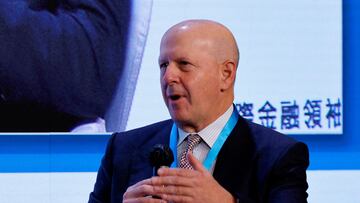Goldman Sachs predicts ‘softer landing’ for US economy: what does that mean for jobs and inflation?
Goldman Sachs CEO David Solomon says Wall Street is predicting a “soft landing,” but what does that mean for workers who are seeing the wages fall...

Federal Reserve Chairmen Jerome Powell has warned that the impacts of the central bank’s rate hikes have not begun to impact the US economy. Regardless, inflation is falling, leading financial markets to rally after a turbulent 2022. The renewed strength of the stock market has some leaders of the financial sector, like Goldman Sachs CEO David Solomon, predicting that the economy could stabilize without a disruptive recession.
Solomon sees the performance of stocks in recent weeks as evidence that “the market has a sense that we’re putting inflation in the rearview mirror.” There are still likely to be ‘twists and turns,’ but the executive believes the “chance of a softer landing feels better now than it felt six to nine months ago.”
Fed Rate hikes and the chance of a “soft landing”
These comments were made just before the Bureau of Labor Statistics released the January Consumer Price Index report, which showed an increase of 0.05 percent in average prices last month. The Federal Reserve aims to keep inflation under one or two percent a year, so an increase of 0.5 percent is a red flag. If prices rise at that rate, the annual inflation budget will be consumed in just four months.
The relationship between low unemployment and consumer resilience
While the January inflation numbers have shaken money markets, Solomon’s analysis is, in part, based on how consumers have responded to higher prices. The Goldman Sachs executive said described consumers in the US as “much more resilient than people expected.” Consumer resilience, from Wall Street’s perspective, refers to the continued strength in aggregate consumer demand as prices have trended upward. Investors and corporate executives have noticed a willingness by consumers to tolerate higher prices.
However, Solomon and others should remember that inflation has impacted the food, healthcare, energy, and housing markets which are unlikely to see stark changes in demand when prices fluctuate. Casting tolerance of higher prices as resilience erases the pain inflation has caused and the lives it has upended. Homelessness and food insecurity both increased in 2022, following a year where over one hundred thousand people died of drug overdoses. Last year also saw real wages fall by 1.8 percent while corporate profits rose to record levels. Real wages refer to the purchasing power of a worker’s income, whereas nominal wages represent any change that may or may not impact one’s disposable income.
During the first three quarters of 2022, domestic industries saw profits increase by 7.7 percent compared to the same period in 2021.
What few in Solomon’s position have been asked is why they believe that consumer demand has remained strong. The Federal Reserve has a reason: low unemployment. Earlier this month, Federal Reserve Governor Christopher J. Waller described the impact of the BLS’s announcement that half a million jobs had been added to the economy in January.
“Such employment gains mean labor income will also be robust and buoy consumer spending, which could maintain upward pressure on inflation in the months ahead,” said Governor Waller.
Even when workers are seeing their disposable income fall, they, rather than the organizations that employ them, are to blame for inflation because “the very strong labor market makes it hard to find and retain workers.”
Economists talk a lot about the equilibrium of supply and demand, and it can be helpful to imagine labor as goods bought and sold like any other.
When there is a shortage of a highly sought-after good or service, the price increases. This logic partly explains the inflationary pressure in global markets we feel today. After the European Union banned the import of Russian energy commodities, the value of those produced by US companies rose because of a sudden surge in demand for them. As production has increased, prices have fallen while demand has remained elevated.
Today, unemployment stands at 3.5 percent, meaning that there are not a lot of unemployed workers looking to sell their labor power. Without an increase in supply, through, say, immigration, workers who are looking to sell their labor power can offer a higher price. In this situation, workers are the sellers, and companies are the buyers. When labor is in high demand, those selling it, workers, are going to offer the highest price that they believe buyers are willing to pay. On this front, resiliency on the part of the private sector has also been seen. Firms, like the average consumer, do not like paying higher prices, but when it is their only option, they will tolerate such increases.
The Federal Reserve reported that in 2022, wages and benefits saw a nominal increase of five percent —a rate inconsistent with the bank’s “goal of stable prices.”
One concern voiced by prominent economists like Joseph Stiglitz is that in an effort to lower inflation, the Federal Reserve could trigger a recession where unemployment rises, worsening the economic position of consumers. Consumers have shown resilience because unemployment has reached a historic low. If unemployment rises, aggregate consumption will fall, and that “soft landing” will lose any cushion, particularly for low-income workers struggling to remain housed and with food on the table.






